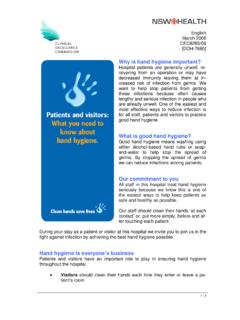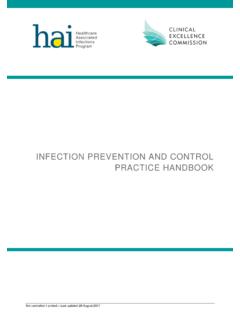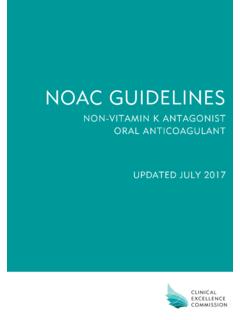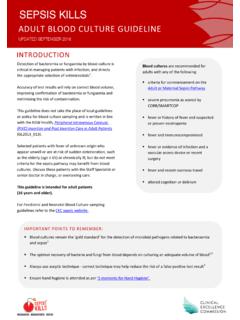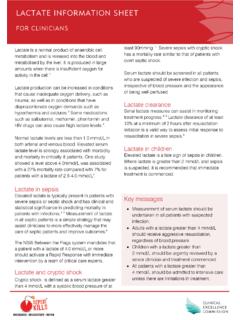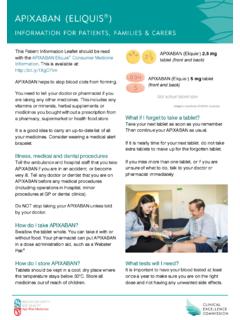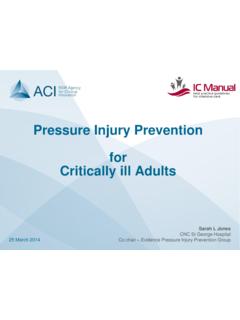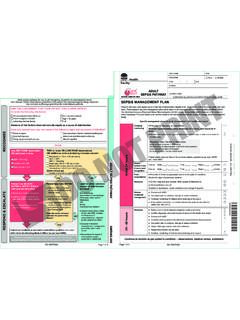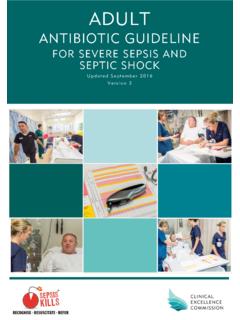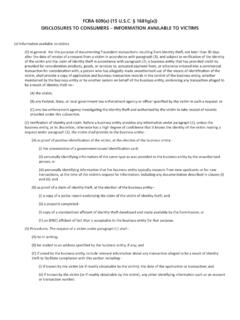Transcription of Guidelines for Conducting and Reporting Morbidity and ...
1 Guidelines for Conducting and Reporting Morbidity and Mortality/Clinical Review Meetings Clinical Excellence Commission 2020. All rights are reserved. In keeping with the NSW Government's commitment to encouraging the availability, dissemination and exchange of information (and subject to the operation of the Copyright Act 1968), you are welcome to reproduce the information which appears in this publication, as long as the user of the information agrees to: use the document for information only save or print a single copy for personal use only and not to reproduce any major extract or the entire document except as permitted under Copyright Act 1968 (as amended) without the prior written permission of the State of New South Wales acknowledge the source of any selected passage, table diagram or other extract reproduced not make any charge for providing the Information to another person or organisation without the prior written consent of the State of New South Wales and payment of an agreed copyright fee not modify the Information without the express prior written permission of the State of New South Wales include this copyright notice in any copy made: - Copyright Clinical Excellence Commission for and on behalf of the Crown in right of the State of New South Wales.
2 SHPN: (CEC) 200272. ISBN: 978-1-76081-416-8 (print); 978-1-76081-417-5 (online). Clinical Excellence Commission Board Chair: A/ Prof Brian McCaughan, AM. Chief Executive: Ms Carrie Marr Any enquiries about or comments on this publication should be directed to: Clinical Excellence Commission Phone: +61 2 9269 5500. Email: Guidelines for Conducting and Reporting Morbidity and Mortality/Clinical Review Meetings September 2020. Page 0 of 27. Contents 2. Acronyms .. 2. Introduction .. 3. Purpose and scope .. 3. CEC Quality Improvement Data System M&M meeting module .. 3. Core 4. 1. Safety .. 5. 2. Multidisciplinary .. 7. 3. A Meeting Framework .. 9. Review of deaths .. 11. 4. Comprehensive discussions .. 13. Examples of Case Discussion Themes to 15. 5. Lessons Learned .. 16. 6. Governance .. 18. NSW Legislation .. 20. Appendix A: Example of M&M/ clinical review meeting Terms of Reference.
3 21. Appendix B: Example of Morbidity and Mortality Meeting Report .. 22. Appendix C: Example of Quarterly Morbidity and Mortality Summary Report .. 23. Appendix D: Cognitive Autopsy Guideline .. 24. References and Relevant 26. Suggested 26. Suggested readings and links for M&M Chairperson .. 26. Useful Links .. 26. Guidelines for Conducting and Reporting Morbidity and Mortality/Clinical Review Meetings September 2020. Page 1 of 27. Glossary Also known as Ergonomics is a scientific discipline focused on Human Factors understanding the interaction between people and their environments A culture where staff can raise issues of safety without fear of Just Culture retribution, even if it is errors, they themselves have made. A culture where people are not blamed for mistakes A traditional approach to safety management with a focus on Safety 1 learning from clinical incidents or what went wrong and often uses a cause and effect methodology An understanding of safety management with a focus on positive outcomes including understanding of systems that support good Safety 2.
4 Outcomes despite high complexity. An understanding of what went right and why Refers to the interacting dynamics between; self, team, environment and patient and how they work together to contribute to outcomes. Based on the concept that a system, not any one individual, is Systems thinking responsible for both good and bad outcomes. A system's function is more than the sum of its parts (of which people are just one part); it's the product of its interactions Includes clinicians from across disciplines including; nursing, Multidisciplinary midwifery, medical, allied health and pharmacy Acronyms IIMS Incident Information Management System ims+ Incident Management System QIDS Quality Improvement Data System LHD Local Health District TOR Terms of Reference DMS Director of Medical Services DoNM Directors of Nursing and Midwifery SCIDUA Special Committee Investigating Deaths Under Anaesthesia CHASM Collaborative Hospitals' Audit of Surgical Mortality Maternal and Perinatal Mortality Review Committee RCA Root Cause Analysis Guidelines for Conducting and Reporting Morbidity and Mortality/Clinical Review Meetings September 2020.
5 Page 2 of 27. Introduction Morbidity and Mortality meetings (M&Ms) or clinical review meetings allow departments/. specialties/ facilities to review the quality of the care that is being provided to their patients and to identify any opportunities for improvement. M&Ms have an established history and culture and are an invaluable tool for engaging the significant expertise of clinicians at the point of care. However, patient care is delivered in complex interactive systems and clinical review of care needs to reflect an understanding of systems versus individual factors to ensure comprehensive recommendations for change and clinical improvement. In addition to the review of adverse clinical incidents and outcomes, there is a growing trend in M&Ms to identify how resilience within complex systems enables positive outcomes in the face of challenges and uncertainty which are inherent within healthcare delivery.
6 Lastly, M&Ms are often a key opportunity for clinical staff to engage in the processes of patient safety and quality improvement and therefore represent an important opportunity for education regarding these processes as well as for senior staff to model appropriate professional behaviour. Purpose and scope This document follows on from the previous Guidelines developed by the Clinical Excellence Commission (2016) (CEC) and provides a methodology for M&Ms using 6 core principles, guided by Human Factors and systems thinking to support comprehensive discussion from a diversity of clinical perspectives and generate system improvement opportunities. The Guidelines support an evolution in clinical review processes away from linear cause- effect models centred on the individual most proximal to the adverse outcome, to more complex systems analyses that incorporate consideration of the organisational factors that both support and constrain individual practitioners.
7 They also reflect a shift from an isolated focus on the absence of negative events (Safety 1 view) to the incorporation of understanding how things more often go right despite varying conditions (Safety 2 view). The core principles explore the interaction of identified key structures, process/ procedures and relationships/ people. Each principle also includes characteristics of what the minimum standard and the gold standard M&M would look like with examples of how this has been implemented across Local Health Districts (LHDs) within NSW Health. CEC Quality Improvement Data System M&M meeting module A core theme throughout the Guidelines is access to meaningful patient level data to support the M&M processes. The CEC has various systems available for clinicians to use including the Quality Audit Reporting System (QARS), the Death Review database and, more recently, the Quality Improvement Data System (QIDS).
8 QIDS has been developed to support learning and identify improvement opportunities using available data. For example: QIDS. presents Hospital Acquired Complication (HAC) data from the Health Information Exchange (HIE), IIMS & ims+, hand hygiene and other sources. Analysis of HAC rates at LHD, hospital and ward levels is easily performed and offers multiple options for identifying opportunities for improvement by seeing trends and patterns. Guidelines for Conducting and Reporting Morbidity and Mortality/Clinical Review Meetings September 2020. Page 3 of 27. An M&M module has been developed in QIDS to further support and enhance the implementation of these Guidelines and will include key templates and resources. Access to QIDS and the M&M meeting module can be arranged through the Clinical Governance/. Patient Safety unit within each LHD. Core Principles The six core principles were identified through a literature review and have been further developed in consultation with key stakeholders across NSW Health.
9 Each of the principles is outlined in the document with some brief points in relation to the minimum and gold standard requirements to meet these principles. 1. Safety: a safe space for learning 2. Multidisciplinary: enhancing active participation across the disciplines 3. Meeting Framework: systematic agenda selection process with support from clinical analytics 4. Comprehensive discussions: to generate actionable learning and/ or system improvement 5. Lessons Learned: documentation of lessons learned and dissemination of recommendations to ensure action 6. Governance: pathways for Reporting to support learning and recommendations Guidelines for Conducting and Reporting Morbidity and Mortality/Clinical Review Meetings September 2020. Page 4 of 27. 1. Safety A Safe space for learning Minimum standard Gold Standard Safe, blame-free environment focusing on Meeting atmosphere that is conducive to discussion for learning not for judgement and open discussion with a focus on Just recognising the influence of hindsight, outcome, Culture with an emphasis on the system not and other biases on individuals Established pattern in meeting occurrence and Regular monthly meeting duration depending on the facility Written terms of reference: updated annually and Shared understanding and accountability given to all committee members enabling a positive team culture Meeting agenda and cases to be presented to be Early identification of emerging themes to disseminated prior to the meeting allow opportunities for discussion and learning Staff feel they have permission' to attend.
10 Staff are encouraged to attend and feel their contributions are valued. Structure Shifting from a linear, attribution-focused perspective towards a systems perspective enables individual actions to be placed within the context of the systems in which the incidents occurred. The systems approach considers the interacting dynamics between human factors, the team(s), the environment and the patient. M&M reviews consider these complex, interactive systems and reflect on clinical outcomes from this perspective, recognizing that individual incidents may in fact reflect symptoms of a wider drift away from safety within local systems and/ or processes. Process/ procedures Meetings are held on a regular basis as required and specified by the relevant local governance process The Chairperson is responsible for creating an atmosphere that is conducive to open discussion and should ensure all members have an opportunity to contribute The Chairperson is responsible for ensuring that discussions are used for educational and system improvement purposes and not for apportioning blame to individuals Terms of Reference (TOR) are developed and a copy made available to all committee members.

